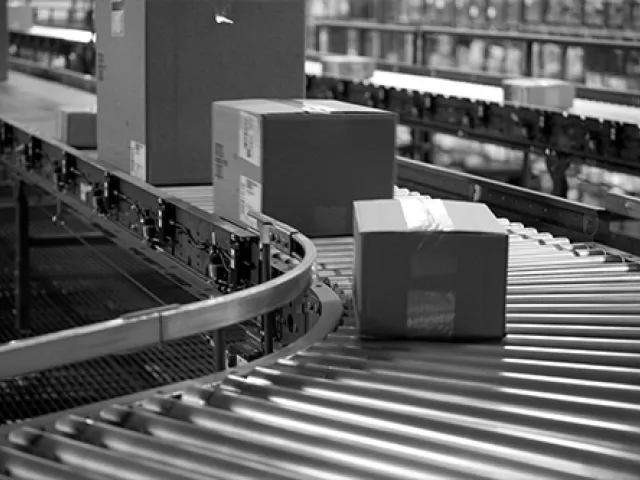Table of contents
Key Takeaways
-
The first step to transforming your end-to-end supply chain is understanding where the defects are today.
-
The next steps include embracing digital technologies, retraining staff, and implementing predictive analytics.
- Today's supply chain leaders are tasked with reinventing business models every 2-3 years.

TraceLink’s Roddy Martin talks supply chain transformation with BlueWorld Supply Chain Consulting CEO Jake Barr, who spent more than three decades as Global Director of Supply Network Operations at consumer goods giant Procter & Gamble.
Transcript:
In this week's episode of The Agile Supply Chain Podcast, TraceLink Digital Transformation Strategist Roddy Martin talks to BlueWorld CEO Jake Barr, who shares insights from more than three decades as the former global director of supply network operations for Procter & Gamble.
Roddy Martin: Welcome, Jake. It's good to have you on TraceLink's thought leadership series talking about your experience in agile supply chain and supply chain transformation at Procter & Gamble. Jake, would you introduce yourself? Give us a little bit of your background in supply chain transformation.
Jake Barr: Roddy, thank you. Thanks for having me. I did three-and-a-half decades as a supply chain leader at Procter & Gamble. I had the honor of working and leading a team that was devoted to our transformation, initially tied to remaking our business model to be outside‑in, focused on consumer‑driven and the two moments of truth.
Then, later, putting in our global control towers from which we digitized the business, and managing our end‑to‑end supply chain, from our suppliers all the way through to our channel partners. Subsequently, I've led a boutique supply chain consulting firm. We do business across about seven verticals.
Roddy: Jake, you've touched on a couple of points that are key in healthcare. One is “patient-back” or “shopper-back,” as Procter & Gamble calls it. The second is “moment of truth.” The third is how you design the business. Talk a little around moment of truth because it's directly translatable to the patient in healthcare. What did that drive? What kind of new metrics and behaviors did it drive in Procter & Gamble?
Jake: The recognition was that the way we were running our cycles and sequencing of our supply chain was actually inside‑out instead of outside‑in.
The "aha" moment came when our chairman and CEO at the time was focusing and trying to push us to recognize that if you can't win at the touch point where the consumer chooses to interact with the company—no matter whether that's through various channels or whatever—you never have an opportunity to get them to come back. We were experiencing business outages.
In the grand scheme of things, we were a benchmark across our industry for service and supply, but the numbers do lie. When you look at it you say: We're 99 percent service level but wait a minute. What is the value of the one percent? The one percent, across a global business as big as ours, was literally a billion dollars.
When you think about retooling, what you have to do is understand that the cadence and the sequence with which all your processes work, from that touch point with the consumer or the patient coming back, you have to rewire them. It's both process and technology. I would say it's process leading the technology for how to apply those.
Roddy: That in itself is an important point. Jake, I want to pick up on a point you and I have spoken about many times, and that is Procter & Gamble, leading manufacturers never chase after 100 percent demand‑focused accuracy. It's just not possible.
However, P&G always used to say, "If we get it 95 percent right, that's great, but we know our capabilities so well that even within that four or five percent inaccuracy, we're still agile enough to deliver on‑time, in-full to the shopper shelf." Talk a little bit about that.
That's a challenge that I don't think a lot of pharma companies, who've been protected by high margins and putting hundreds of days' worth of inventory in all of the supply chains—that's not the way they've operated.
Talk a little around that challenge of operations excellence and delivering to schedule, delivering to plan, and meeting the requirements to be available at the shelf or at the patient in healthcare.
Jake: Every industry has different cycle links around their production process in QA vetting and regulatory requirements, etc. At its very core, you have to ask yourself, "What is it I need to do to be continuously improving the agility and the response time of that process?"
We always looked at the entire end‑to‑end supply chain as a machine instead of viewing it as disconnected pieces that required you to build huge buffers. Obviously, you need some buffers to cover safety, but really, the transformation that I'm witnessing in life sciences is very similar to virtually every fast consumer type of the business today.
The product lines that they used to have are morphing into, shorter‑cycle, higher, more frequent expiry‑type products that are individually crafted—all the way down to DNA‑specific drug regimens, etc.
The process that you're referring to, as you think about how you're doing process control and not only shop floor operations, you have to have a level of intellect around where the defects are, how the lines are running, whether you're running off center line or not, whether you're drifting in your performance. You can't wait until after to address it. You have to put in countermeasures.
To your point on metrics, our metrics changed significantly. How we were rewarding our people, whether they were in managing a plant that had shipping responsibility. It wasn't, "Did I just get it in a truck on time?" It's, "Did I fulfill it all the way to the point of consumption on time?" That changes the methodology. It changes your psyche of how you think about running the shop.
Am I going to delay shipping something? Am I going to go back and rework some of the causes of the reason why I'm holding a truck to be able to get out so that I can be more agile into the market? I call it crawl‑walk‑run. Obviously, you have to roll up your sleeves, do the work on the process side to understand where the defects and the level of losses are.
It requires a commitment to getting more digital in how you capture data and analyze the data. It requires your people to become more proficient at identifying those gaps and issues, and then for you to install predictive capability so that you know up front instead of reacting afterwards.
Roddy: One of the other best‑in‑class benchmarks that I have with P&G is the supply chain team got on with the day‑to‑day business of making sure product is available on the shelf. There was a strategy team under the consumer‑driven supply network team, under yourself, under the chief supply chain officer that was focused on building and codifying capabilities and best practices across the business.
My biggest challenge that I have to mentally grasp is how on earth pharma companies are going to build this brand‑new supply chain capability by people doing strategy capabilities and building new capabilities in their spare time, as well as running the business. Talk a little bit about the consumer‑driven supply network team.
What was the day‑to‑day focus of the business? Where did you report in the business? What sort of impact did you have on the implementation of supply chain strategy?
Jake: The great news is we were directly responsible for delivering business outcomes. I don't suggest any team that's responsible for a transformation effort be disconnected from the operating outcomes. It has to be part of how they're rewarded as well.
You're not doing this for fun. You're doing it because you're trying to transform how you deliver a measurable output, the revenue for the company, the margin for the company, the agility, the cash that's required, so they can free up cash to put it back into product innovation and new equipment purchases, etc., all those things that keep you ahead instead of running from behind.
I want to speak for a second to the first part of your question because it was a multi-part one. You've got to understand—I want to go back to this machine analogy—the farce for most people, the error for most people, is that they believe that besides the unit op that's metal, that's connected to the floor, the rest of their work really isn't a machine. The reality is it is.
It's got process controls and defects, so if you don't step back on the people element, you said, "Hey, wait a minute. What were we trying to do to codify?" We recognized that despite having one of the most exhaustive implementations of ERP backbones on the planet, etc., it was all the same, by the way.
We had huge variability in how processes were being executed, people setting different parameters for how the machines would operate, even though they were sitting side by side, working on the same machine. We literally got it down to understanding that not only did we have to give people initial training, but we had to validate and qualify their skill level.
I'm working with a couple of companies now, Roddy, coming out of the pandemic. Reality set in as the pandemic started to hit its peak. The companies in question, some very big‑nameplate companies who stepped back, and they couldn't answer very basic questions of, "How much capacity do we have? How quickly can we get it into the market?"
Their people, across the unit ops, were calculating the capacity differently, one of the more basic, fundamental things. If you don't invest in the people that you have that are the machine, how do you ever expect it to generate the performance and the business outcome?
In the kind of chaos that we operate in today, high levels of demand volatility, needing to change the way the network is connected, the ecosystem, using more contract operators, getting assembly centers, new suppliers, it's a constant flow and flush. You've got to invest in the backbone of your people running it and with the technology that you give them to augment.
They can't go off and look at a million transactions per day or a week. They got to have something that goes and does some initial flush and says "Hey, here's where I see 15 issues percolating. Now you determine what to go do about it."
Roddy: Jake, you touch on another really important point. Besides the CDSN team or the consumer‑driven supply network transformation team, the fact that the problem‑solving mechanism or process in P&G was to start where the problem happened and walk back into the supply system.
You find in the healthcare industry, where margins are 80 percent and there's 300 days' worth of inventory, they tend to just stuff the system full of inventory and people will get their product.
Whereas P&G, without those margins, said, "Look. Let's go to every stock outlet. Let's walk virtually from the place at which the problem happened all the way back into the supply network and try and understand, what were the characteristics that we needed to meet up to have this product on the shelf?"
Toilet paper, tissues, health and beauty care all have different cycle times, all have different demand patterns. The most intriguing part of the story is the fact that you've got about 400 percent returns from a set of losses, simply because to your words, you found problems that existed as you walked from the shelf back to supply you didn't even know existed.
Those are not only technology, those are people, process, and technology issues.
Jake: I describe it as it's the gift that keeps on giving. If you link the ecosystem, there is so much underneath the surface. It's like the iceberg. You think the loss is what's poking through the water. For us, it was that initial out‑of‑stock.
The reality is, there was four to five times that amount underneath the surface all the way from the suppliers to the channel partners that we weren't seeing because we couldn't get to that level. Once we peeled off the top and started dealing with that, the box opened up again and we said, "Oh my God, there's another setup. There's more money here." It just kept raining money.
Roddy: I think that's profound, because I honestly believe that's where the healthcare ecosystem is going to go. I mean, yes, there are obvious issues like, "This product wasn't serialized. This product was in a cold chain and you lost the temperature, so we're going to throw it all away."
As you dig down in these issues, there's going to be layers and layers of people, technology, process issues that you're going to uncover that lead to massive returns for the business. What I think is a best practice at P&G, and there are very few other companies that achieved this, was codifying that approach to instituting best practices. In other words, what are the people best practices?
What are the technology, the processes, etc.? As you look for this issue, as you analyze this issue and you ask why five times and you dig into the root causes, you're going to find lots of problems. You've got to then systematically go and address them.
Jake: You will, Roddy. I want to build on something you said earlier. If you think this is just a simple connecting of the ecosystem, it's not. I want you to understand, it's iterative. You're going to actually make decisions in the early states to link the way the ecosystem is connected that you will then rewire in a couple of years as you peel it out and uncover more.
That to me is one of the strengths when people get into the transformation effort. If they think it is a one‑time deal, they're missing the point. Again, you've heard me use crawl‑walk‑run. In the crawl space, the way you link the process is to get value, the way you'll use technology to get value, the way you'll organize to get value will be different than in the walk and the run stage.
You'll be able to make different changes as you start peeling it back.
Roddy: I think you raise another point, just to go back to the consumer‑driven supply network transformation team, I saw over the 5, 10 years I was involved with you, I saw that team change a number of times. As you go from different business units where their focus is on different products, different cycle times, different challenges.
What may have been central procurement eventually became devolved procurement, which eventually became devolved problem‑solving on sites, which eventually became centralized visibility of the supply chain. There's no one size fits all, stick in a transformation team, walk away, and in five years' time, walk away and you've got a different supply chain.
It required continual nurturing, continually changing the performance and the culture of the organization. What would you say about the leadership of the supply chain organization and how it was perceived in Procter & Gamble as being strategic?
Jake: We, like any other company, went through our own journey. That's still continuing to evolve today. If you look at the challenges of the firm that I no longer am with, they continue to evolve in the approach because the challenges of the demand volatility, it's cycle response time to the channels, the needing to get things in six hours versus two days or three days, where it was before.
The psyche, though, the supply chain leadership, is both a business leader and a supply chain leader. They're expected to bring and identify gaps and opportunities. Now when we're talking about in the business operations planning meeting, which many people call S&OP.
You're looking and saying, "Hey, we're running ahead of pace on the yield rates on the production. We have more we can sell. Where could we take advantage of it? What market? What margin level would we be able to get? Should we run an additional feature in Merchandising? How much could we support?"
Those are completely different dialogues today than they were before, which was the old school, I'd call it, pointing fingers, demand‑and‑supply matching. "You should have been more accurate on the forecast."
"Oh, no, you should have known that your yield was going to be X or Y."
Roddy: Jake, you and I could go on talking for literally a day as we have done on all the benchmarks that I always associate with best‑in‑class from Procter & Gamble.
Let me just reflect on a point that when the pandemic was socialized more broadly, P&G in my opinion was, if not, the first company to come out and say, "These are the thousands of our products, by number, that are going to be impacted because of this disruption in the supply chain."
I still haven't seen many companies come up with any numbers that say, "By the way, 50 percent or 20 percent or X thousand number of our products are simply not going to be able to be delivered, because we're missing the components."
Procter & Gamble, by delivering this control‑tower visibility across the business, just proved that they had a handle on the end‑to‑end capabilities of Procter & Gamble. Any points you'd like to make in closing, Jake? Any advice you'd like to give?
Jake: Yeah, I'd give you two. The first is, no company is perfect. Every company has its challenges. Even in the middle of the pandemic as we're still experiencing the outages, companies are still going to have supply outages.
The question is, are you reacting to them, or are you proactive upfront, knowing they're going to happen and then making business decisions about what you can do about it, how you keep your partners informed, how you use alternate supply if available, how quickly you're able to adjust on the fly to those kind of gaps?
That's the first thing, is realizing, that's where, if you dedicate yourself to this, your process, your technology, your org design, helps to facilitate that more rapidly. The second is, again, just reiterate the point, look, you've got to understand, the transformation effort is a journey. It is a journey. It's not a one‑time effort.
You've got to make that part of your normal routine, to sit down and say, "Forward‑looking, what do we expect the volatility to be over the next 3, 6, 9, 12, 18, 24, 36 months? How are we planning to build our agility to match those changes that we're predicting? What are we doing on the process front to get our people better prepared for that?"
Because the best job description I have for our chief supply chain officer is, in the old world, their job was to report to the CEO and look for some cost savings. In the new world, their job is to actually blow up the business model and reinvent it virtually every two to three years.
Roddy: That's very insightful. On that note, Jake, there's a really good reason why, like Apple, Procter & Gamble was retired from the AMR Research Gartner top 25 in the very early stages. Procter & Gamble was always up in the top five of all of the supply chain companies that were assessed.
It always gives me great pleasure to talk to you and to talk about Procter & Gamble as one of the best benchmarks to supply chain capabilities on the planet. Jake, thank you for making the time. We appreciate it.
Jake: No problems. Hats off to the team that I worked with.
Roddy: Yep, I'm sure. Thanks Jake. Bye‑bye.
Jake: All right. Have a great day.
Return to: The Patient-Driven Supply Network





